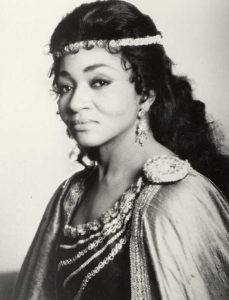
On This Day: A Look at Operas That Grace Bumbry Sang As Both Soprano and Mezzo As She Celebrates Her 80th
By Francisco SalazarOn Jan. 4 Grace Bumbry will celebrate her 80th birthday. The mezzo soprano is recognized as one of the pioneers in the world of classical music who paved the way for future African-American opera and classical singers. The mezzo had the distinction of having a powerful and big voice that sang with commitment and intensity. She was also recognized for her agility and bel canto technique. But what she was also recognized for was her taking on of numerous soprano roles. Bumbry is one of the few mezzos that also made a name for herself as a soprano singing numerous roles. As we celebrate Bumbry’s 80th, Operawire takes a look at some of the operas that Bumbry performed both the soprano and mezzo roles.
“Il Trovatore”
Bumbry was a recognized Azucena particularly for her powerful low notes. However, she was also a recognized Leonora. She was able to lighten her voice to pull off the high D Flat that Verdi writes for the soprano role. If you listen to both her Azucena and Lenora, you will notice how she modulates her voice in order to interpret the character. Her Azucena has a roughness to the sound while her Lenora has a very lyrical and light sound that enables her to pull off the virtuosic coloratura line given to the character.
“La Gioconda”
What soprano does not want to sing the famous “Suicidio?” It is one of the most dramatic arias in the verismo canon and is also part of a very demanding opera. Bumbry has the distinction of singing the full role of “La Gioconda” in several productions. One of the most famous instances was recorded in 1988 when she performed it alongside Fiorenza Cossotto at the Liceu in Barcelona. However, she also performed the mezzo role of Laura before moving on to the dramatic soprano repertoire. In 1967 she returned to the San Francisco Opera for her first performance of of the role with Leyla Gencer as Gioconda, Renato Cioni as Enzo Grimaldi, Maureen Forrester as La Cieca and Chester Ludgin as Barnaba.
“Norma”
This probably one of the most famous instances where Bumbry performed both soprano and mezzo roles. However, this could be noted as cheating because Bellini wrote both Adalgisa and Norma for soprano and not for mezzo and soprano. However, it is famously performed for the mezzo and soprano today. Not many can claim that they sang both roles save for maybe Monserrat Caballe. But not many can claim that they sang both roles in the same season. Bumbry famously alternated Adalgisa and Norma in 1978 at the Covent Garden. She first sang Adalgisa alongside Caballe and then sang Norma opposite Josephine Veasey as Adalgisa.
“Aida”
Recently Violetta Urmana became one of the few to sing both the role of Aida and Amneris to critical acclaim. However before her, Bumbry mastered the role of Amneris and it was one of her signature roles. She performed it to great acclaim around the world including at the Metropolitan Opera alongside Leontyne Price and Martina Arroyo. “Aida” was not one of her most famous forays into soprano roles but she famously made a video in which she sang both roles and in that video one can see the way the voice shifts easily from dramatic mezzo to soprano.
“Tannhäuser”
Wagner roles are not generally high and most mezzos shift to the soprano roles with ease. Isolde in “Tristan Und Isolde” and Sieglinde in “Die Walküre” have been sung by mezzo sopranos. However, it is rare to see the same singer perform both Venus and Elizabeth. Granted Bumbry never performed Venus and Elizabeth in the same night. Still she moved seamlessly through both roles without any difficulty and showed off her voice in the composer’s difficult score.


